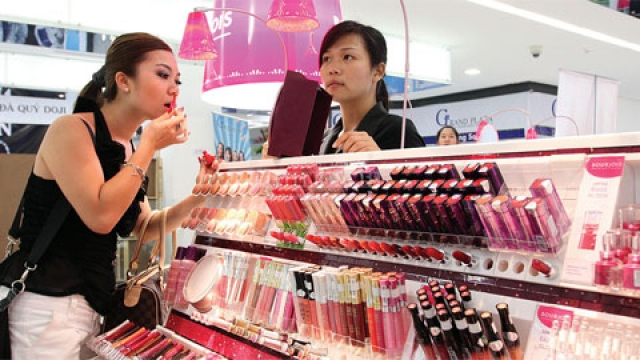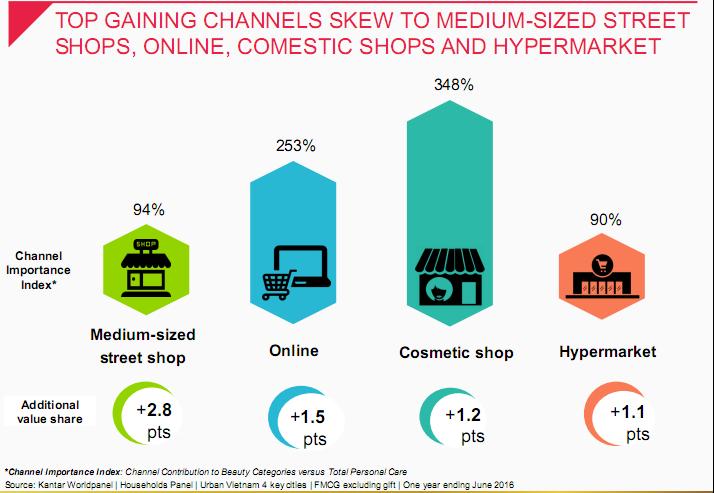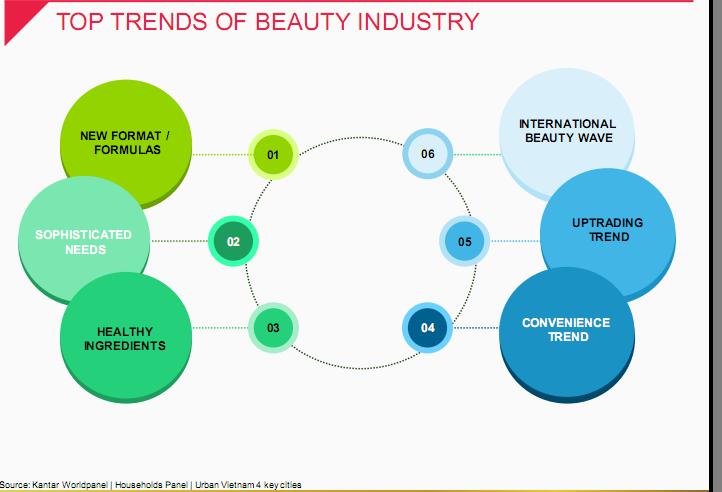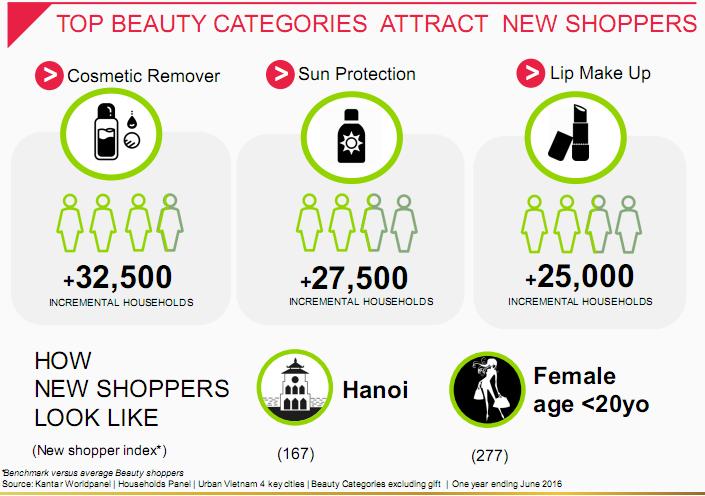Taste in beauty products changing among Vietnamese
women, according to latest report from Kantar Worldpanel Vietnam.
The internet has gradually changed the way people build knowledge, become influenced, and decide on a beauty item. It’s now a crucial topic worth deliberating in any route-to-market plan, he said.
For any manufacturer in any country, the beauty market displays a highly complex and competitive picture: diverse and hard-to-please needs from consumers, thousands of opponents to combat, various influencing touch-points on consumers, and plenty of channels to trade in. Vietnam is no exception but the question for any beauty consumer goods company is how much should they invest to capture consumers, whose spending on beauty products is just 40 per cent of their Thai neighbors and incomparable to Japanese and South Koreans.
Tough as it may sound, fortune always favors the bold. The under-development of the market holds opportunities for everyone to grab a piece of the pie and the largest slice will go to the one who can lead market trends and educate consumers, since beauty knowledge is increasing but not among everyone. By “everyone”, Kantar is referring to the potential base of about 20 million women from 15 to 39 years old, who account for 40 per cent of Vietnam’s female population. Today they receive a better education, know of and access different sources to build their knowledge about a product, and are updated faster than ever before. They are also driven by the sophistication seen from celebrities and beauty bloggers, or by beauty salons and cosmetic shops.
Additionally, an increasing proportion of them are in the workforce, which yields greater disposable income. In return, they care more about appearance, tend to indulge in more nice-to-have categories, and are motivated to pay for more premium and convenient products. According to Kantar Worldpanel’s latest beauty report, there is a strong correlation between both household income and number of working women urban households have and the amount of beauty products they have in their repertoire.
2016 saw the rapid adoption of sophisticated products, such as Make-up, Cosmetic Remover, Toner/Astringent, and Sun Protection. Moreover, despite the down trading trend in the Food and Home Care sectors, the Beauty sector remains the land of premiumization among current users, for example higher priced hair conditioner, skin care and make-up products have gained at the expense of lower-tier products. Beyond consumer goods, there is also rising demand for beauty services through numerous spas/clinics and beauty salons at all levels of price and expertise.
Given the current market size and existing complexities, manufacturers need to consider if it’s time to stop an over-focus on their core portfolio and shift more attention to anticipate changes and sophisticated needs in the future (which require planning and innovation strategies from now). Is it only the job of the market leader to develop the market or also worth others reviewing their product offerings? Is there anything we can learn from the evolution of other Asian or European markets?
In immature and scattered markets like cosmetics, both market leaders and the smaller players can grow the market. Market leaders can educate consumers on the need for and knowledge about proper personal care routines, especially from an early age. Consumer panel data reveals that new beauty product buyers skew to female users less than 20 years old and Facial cleanser is what they prefer to buy for the first time. Hence, recruiting teenagers by sampling, promoting at schools, cinemas, cafeterias or relevant show sponsorships can be considered.
To target more mature consumer groups requires reviewing the current portfolio and expanding to new categories or line extensions to capture the full regime of consumers.
According to Kantar Worldpanel China’s Individual Purchase Panel, girls’ behavior changes as they enter the next stage of life. “They will take more steps in their skincare regimen,” it wrote. “They start to seek self-pampering rather than just having fun. They will look for benefits of high effectiveness: hydrating, anti-aging.” Therefore, investigations should be on what categories are desired in Vietnamese women’s routines and what benefits are missing in portfolios; what new formula or convenient format could be innovated to excite consumers and set trends? On the other side, smaller players can focus on one or a few key products that consolidate their greatest strengths and competitive edge, like unique treatment, ingredients, or formula, etc. This can either help add to the repertoire of current market users or draw the attention of market outsiders with niche needs or seeking something exceptional.
Another point to consider in any marketing strategy is how to stand out in a crowd of thousands of scattered brands. Competitors vary from international to local brands and from branded to unbranded, not to mention the pure natural products deemed safer than commoditized ones. On top of that, the battle is heating up with current FTAs within ASEAN or with Japan or South Korea coming into effect. Lower import tariffs, lower barriers for more international companies to enter Vietnam, and more foreign beauty products, which are already favored in consumers’ minds, now enjoy a wider presence and better pricing. As a matter of fact, imports from South Korea were reported to have grown impressively in 2016 thanks to the FTA with Vietnam. Domestic-wise, local beauty brands whose strengths are high trade discounts, natural ingredients, and quick effects are also gaining favor among both retailers and consumers. In such a dynamic playground, what can help existing manufacturers be more competitive?
First of all, in the context of greater health consciousness and as a result of many scandals and warnings about counterfeit products or harmful ingredients, consumers are becoming more cautious and paying more attention to product labels or origin. A brand can leverage that by polishing its communications with branded quality and safety guarantees, which is especially applicable for long-established and reputable brands in the market. Secondly, part of the communications or innovation plan needs to consider “natural ingredients”, which are undoubtedly gaining consumers’ preference across the globe. Just one note - in the Vietnamese context, “natural” needs to be something local consumers are able to understand and be familiar with. Last but not least, the open door through FTAs also means an opportunity for international players to import their own products from other countries, so local portfolios need to become more innovative and profitable with more premium offers.
Communications and trade channels are no longer as simple as we once thought. The rapid reach and utilization of the internet by consumers poses a challenge for any player in controlling the information spread online, to catch up with the new power of online reviews, and to compete with the ease and subjective influence of online shops. Since beauty categories take up to half of online FMCG purchases in urban 4 key cities, there is a need to expand manufacturers’ footprint on the digital base, either by more focus on digital communications and interaction, cooperating with renowned beauty bloggers, or listing on e-commerce sites, so as to impact shoppers’ path to purchase from everywhere, even secondary cities or rural areas.
Victory awaits those who can drive the market by setting the right trends, offering full routines, exciting consumers with innovations, and capturing emerging touch-points.
*Beauty products include Hair Conditioner, Hair Colorant, Hair Styling, Facial Moisturizer, Facial Wash, Cosmetic Remover, Masks, Toner/Astringent, Lipstick, Eye Make-Up, Face Make-Up, Nail Make-Up, Hand & Body Care, Sun Protection, Deodorant, and Fragrances.





Leave your comment on this story